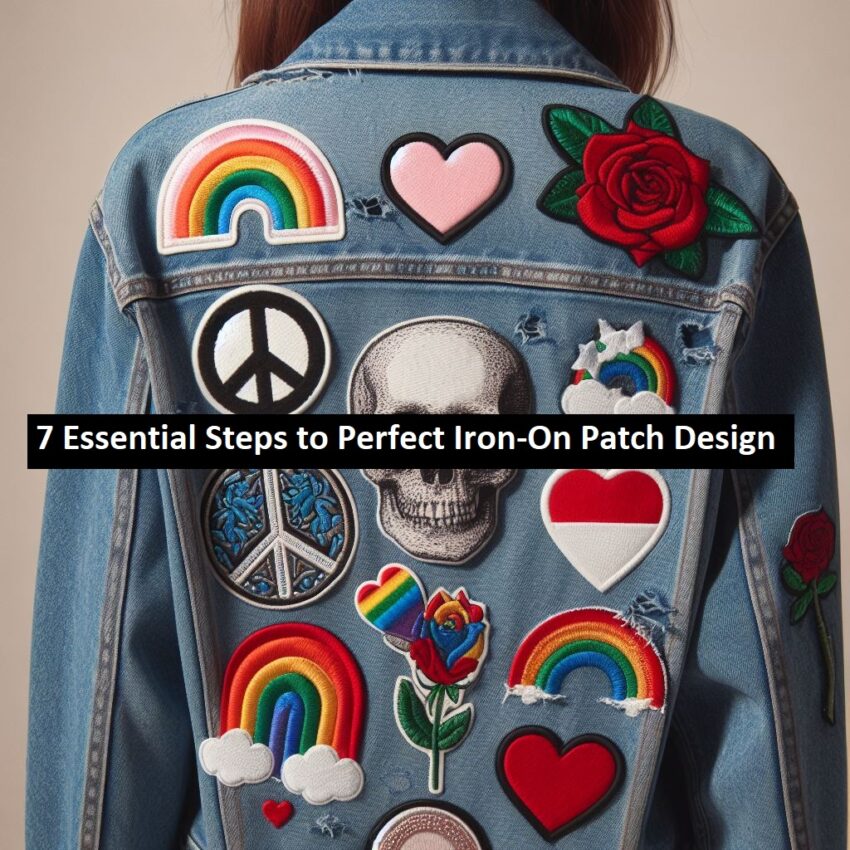7 Essential Steps to Perfect Iron-On Patch Design

Iron-on patches are more than just a way to cover up a tear or hole; they’re an art form, a personal statement, and a fun way to customize your clothing and accessories. Whether you’re a craft enthusiast making unique gifts, a DIY hobbyist upgrading your wardrobe, or running a custom apparel business, nailing the perfect iron-on patch design can make all the difference. The right patch can elevate an ordinary piece into something extraordinary, turning heads and sparking conversations.
In this guide, we’ll walk you through seven essential steps to help you create flawless iron-on patches. From selecting the ideal fabric and sketching your dream design to masterfully ironing it on and ensuring it lasts through countless adventures—each step is crucial in achieving that perfect finished product. So grab your materials and let’s dive into crafting those eye-catching patches you’ll be proud to show off!
Choose the Right Fabric
Selecting the perfect fabric is a crucial first step in ensuring your iron-on patch design not only looks great but also lasts. Compatibility is key; some fabrics adhere better to iron-on patches than others. For instance, natural fibers like cotton and denim are excellent choices because they provide a smooth surface that allows the adhesive backing of the patch to firmly bond. On the other hand, synthetics such as nylon or polyester can present challenges as they tend to melt under high heat and may not hold patches well.
Durability should also be at the forefront of your considerations. If you’re working on garments that will face regular wear and tear – say a heavy-duty work shirt or frequently worn jacket – sturdier fabrics are imperative. Denim and twill are robust options that can endure both the ironing process and everyday use without deteriorating. In contrast, lightweight fabrics such as silk or rayon might be less ideal since they could easily get scorched during application or fray over time.
Lastly, don’t overlook texture when selecting your fabric. While smoother textures facilitate easier adhesion of patches, textured surfaces add a unique aesthetic dimension but require extra caution during application. For example, applying an iron-on patch to corduroy demands meticulous attention to avoid misalignment between the ridges of the fabric and the patch itself. By carefully considering compatibility, durability, and texture from the outset, you’ll set a strong foundation for creating beautiful and lasting iron-on patch designs.
Design Creation and Inspiration
The first step to bringing your iron-on patch vision to life is to dive into the creative process of sketching your ideas. Begin by brainstorming different themes, icons, or images that resonate with your personal style or the purpose of the patch. This might include anything from whimsical floral designs for a spring-inspired collection to bold geometric patterns for a modern twist. Grab a sketchpad and let your imagination flow freely—don’t be afraid to create multiple rough drafts. These initial sketches are foundational as they allow you to visualize and refine your concepts before jumping into digital design.
Once you’ve honed in on a few strong ideas through sketching, transition them into digital format using design software. Programs like Adobe Illustrator, CorelDraw, or even user-friendly options such as Canva can help bring precision and detail to your work that hand-drawing simply can’t achieve. Digital tools enable you to experiment with intricate shapes, adjust proportions effortlessly, and incorporate text elements seamlessly. Particularly when designing patches that will be mass-produced, these programs ensure consistency and quality control across all units.
Moreover, utilizing design software provides the opportunity for endless customization and experimentation without wasting physical materials. You can easily tweak color schemes, try out different textures, or layer elements until you’re satisfied with the final look. A notable example includes stylized monograms where combining handwritten initials with background patterns can create unique personalized patches perfect for custom apparel businesses. Remember, though technical skills in graphic design are beneficial, don’t shy away from exploring tutorials available online—the most important aspect is allowing your creativity to flourish within these digital boundaries.
Selecting Quality Materials
Choosing the right materials is a critical step in creating perfect iron-on patches, as it determines the patch’s durability and overall aesthetic. When it comes to selecting fabrics for your high-quality iron-on patches by Anything Chenille. Remember that not all fabric types react equally under the heat of an iron—some might melt or discolor—so always perform a small test before committing fully.
Equally important is the type of thread used in your patch design. High-quality embroidery threads such as rayon or polyester are recommended because of their strength and sheen. These threads not only add a professional touch but also ensure that the colors remain vibrant even after multiple washes. Similarly, consider using embroidered backing materials like twill or felt that provide stability to prevent curling edges and maintain the shape of your design over time.
Lastly, do not overlook the quality of the adhesive backing material on your iron-on patch. Poor-quality adhesives often lead to peeling or lifting at the edges after just a few washes, undermining all your hard work. Look for commercial-grade adhesives specifically designed for fabric applications—they offer excellent bonding properties ensuring your patches stick well on both smooth and textured surfaces. Investing time and effort into selecting top-quality materials will pay dividends in producing stunning patches that stand up to wear and tear while showcasing intricate designs clearly.
Perfecting Your Color Scheme
Choosing the right color scheme for your iron-on patches is a crucial step in ensuring that your final product stands out and captures attention. Start by selecting colors that complement each other well; this often involves understanding basic color theory, such as using complementary colors (those opposite each other on the color wheel) to create vibrant contrast or analogous colors (those next to each other on the wheel) for a more harmonious look. For instance, pairing navy blue with orange can make your design pop, while using various shades of green together creates a soothing, cohesive patch.
Once you’ve narrowed down potential color combinations, it’s essential to test them out before committing to your final design. You can create small swatches of fabric and apply sample patches or use digital design tools that offer color preview functionalities. Many programs allow you to experiment with various hues and saturation levels until you find the perfect blend that matches your vision. You may find that some colors work better in smaller quantities as accents while others should dominate the patch.
Additionally, consider the impact of different textures and finishes on your chosen colors. Matte threads have a subtle effect that’s ideal for intricate details, whereas metallic or glossy threads can add a flashy element suitable for bold designs. Planning how these elements interact visually will save time and reduce errors during execution.
Don’t be afraid to gather feedback during this stage—show your mock-ups to friends or colleagues who share an eye for design. Their insights might reveal unexpected improvements or confirm that you’re on the right track. Ultimately, taking the time to perfect your color scheme ensures that every patch you create not only meets but exceeds aesthetic expectations.
Read: Tie-Dye Triumph: USA’s Fashion Landscape Transformed in Living Color
Proper Iron-On Technique
After you’ve perfected your color scheme, the next crucial step is mastering the iron-on technique to ensure that your patches adhere flawlessly. Preparation is key; start by washing and ironing the base fabric you’ll be applying the patch to. This removes any residues or wrinkles that could interfere with adhesion. Additionally, place a piece of cardboard or a thick cloth underneath the fabric area where you plan to apply the patch to prevent transferring heat damage to surfaces beneath.
Once your materials are prepped, follow these steps for a successful application: First, preheat your iron to a temperature setting between wool and cotton—usually around 300 degrees Fahrenheit—without steam. Position the patch on your fabric correctly by measuring its alignment with other design elements or garment seams if necessary. Cover the patch with a thin pressing cloth (something like parchment paper works well), which acts as a barrier to avoid burning or melting delicate fibers.
Press down firmly with the iron for about 15-30 seconds, making sure even heat distribution over the entire patch surface—apply enough pressure but don’t move the iron around as it can shift your patch out of place. After lifting off the iron, allow everything to cool for a minute before inspecting your work. If some edges still seem loose, repeat pressing for short intervals until all parts adhere securely but don’t overdo it, too much heat can damage both patch and base material.
Mastering this process may take some practice so don’t get discouraged if initial attempts aren’t perfect! Assess each try and refine based on what went well or could improve; consistency lies in keen attention to detail combined with methodical execution of each step involved. Enthusiasm and patience will soon have you creating flawless patches that bring vibrant individuality and professional finesse to every project!
Post-Ironing Care Tips
Ensuring the longevity of your iron-on patches requires mindful post-ironing care, starting with proper washing techniques. It’s essential to wait at least 24 hours before washing the newly applied patch to allow the adhesive to set fully. When you do wash, turn the garment inside out and use a gentle cycle with cold water. Harsh detergents can wear down adhesives over time, so opt for mild detergent instead. Avoid using bleach or other strong chemicals that could fade colors and weaken the fabric bond.
Handling your patched garments with care will further extend their lifespan. When it comes to drying, air-drying is gentler on iron-on patches than machine drying. High heat from dryers can cause patches to loosen or peel at the edges over time. If you’re in a hurry and must use a dryer, select the lowest heat setting possible and ensure that your garment is still turned inside out.
Iron-on patches can also suffer from wear and tear due to friction and constant movement. To mitigate this, avoid placing patches on areas prone to excessive bending or stretching, such as elbows or knees, unless they are reinforced accordingly. Regularly inspecting your patches can also help catch any issues early—if you notice any lifting edges, addressing them promptly by ironing again with a pressing cloth between the patch and iron will maintain their pristine appearance.
Incorporating these care tips into your routine ensures that your custom designs endure through numerous wears and washes. By carefully considering both washing methods and everyday handling practices, you’ll keep your iron-on patches looking vibrant and securely attached for years. Embrace these preventative measures to preserve not only the aesthetics but also the sentiment embodied in each unique patch you’ve created.
Troubleshooting Common Issues
Despite your best efforts, you might run into a few hiccups when applying iron-on patches. One of the most common issues is lifting edges or peeling patches over time. This usually happens because the patch wasn’t securely adhered in the first place. To nip this problem in the bud, ensure that you’re using enough heat and pressure during the initial application—often a bit more than you’d think is necessary. If edges do start to lift, a simple fix involves re-ironing with a pressing cloth on top to protect both the patch and fabric from additional damage.
Another frequent concern is dealing with bubbles or wrinkles under the patch fabric, resulting from uneven ironing. These can be tricky but not impossible to correct. Use a needle to gently poke tiny holes where bubbles have formed, then reapply heat while pressing down firmly but evenly. Make sure you use even strokes of your iron rather than circular motions which can exacerbate wrinkling.
Lastly, if you realize you’ve made an error in positioning your patch or want to remove it entirely without damaging your garment, you’re not out of luck! Lay wax paper over the patch and apply heat again; this helps soften the adhesive just enough so you can peel back the patch carefully with minimal residue left behind. To clean up any leftover adhesive, rubbing alcohol on a cotton ball should do the trick—just test it on an inconspicuous area first to ensure no discoloration occurs.
By proactively addressing these common issues and armed with these solutions, you’ll not only save your project but also gain confidence in handling future hiccups like a pro. This ability to troubleshoot ensures that each iron-on endeavor turns out as polished and lasting as possible.
Bringing It All Together
Creating the perfect iron-on patch design involves several essential steps. Start with choosing the right fabric that complements your design and ensures durability. Sketch out your ideas, and then bring them to life using precise design software. Select high-quality materials, including fabrics, threads, and backing, to guarantee a professional finish. Pick colors that work well together and test various combinations to find what looks best. Follow a proper ironing technique to ensure your patch adheres correctly, and use post-ironing care tips to maintain its quality over time.
Finally, don’t forget to troubleshoot any common issues that may arise. Now that you know these key steps, it’s time to unleash your creativity! Experiment with different designs and personalize your patches to fit your unique style. Every project is an opportunity to learn something new and further refine your skills. Happy crafting!


